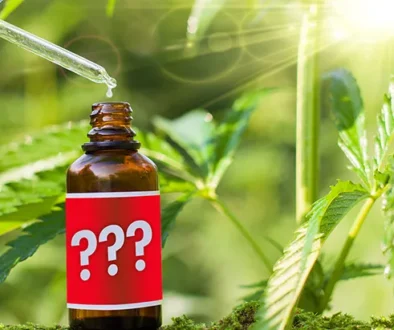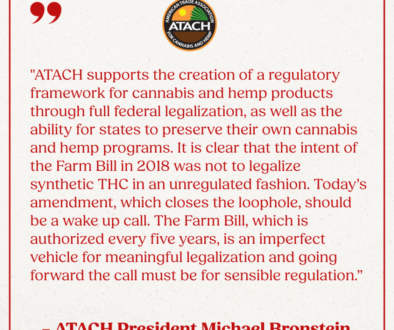THC Vaping Health Issues Warrant Safety Standards
Expert Analysis – Opinion
By Seth Goldberg and Justin Stern
Law360 (September 25, 2019, 3:44 PM EDT) — Vape, vaping, vaporizer, vape pen, e-cigarette, e-hookah, e-liquid and electronic nicotine delivery systems, or ENDS, are all terms that have become increasingly familiar to the general public as media outlets report about health-related conditions resulting from vaping.
As of Sept. 25, nine deaths and more than 500 cases of illness allegedly related to vaping have been reported. As a result, federal and state regulators are investigating, consumers are filing lawsuits and politicians are calling for change, including President Donald Trump signaling a prohibition of ecigarettes may be in the offing.
This article looks at the current vaping issues from the standpoint of the cannabis industry, which is in the crosshairs because tetrahydrocannabinol, or THC, the psychoactive chemical produced by the plant Cannabis sativa L, and cannabidiol, or CBD, a nonpsychoactive chemical produced by cannabis, are frequently vaped, and cannabis vaping has been implicated in the current dilemma.
As Michael Bronstein, president of the American Trade Association for Cannabis and Hemp, or ATACH, explained, “the industry is deeply concerned regarding recent headlines of illnesses associated with vaping and continues to monitor developments as additional information emerges.”
Vaporizers, or vapes, are comprised of a rechargeable component, usually a lithium battery, that is used to heat an oily liquid, known as e-liquid, contained in a refillable tank to create a vapor that is inhaled. E-cigarettes also use a rechargeable component, but instead of an oil tank, the eliquid combusted in most e-cigarettes is contained in a small disposable cartridge that is discarded after the oil has been consumed.
E-liquids can contain a variety of substances, such as flavored nicotine, flavorings, THC and CBD. Many e-liquids are also mixed with diluents and combined with cutting agents, and THC or CBD e-liquids are often mixed with cannabis terpenes, a type of oil derived from resin glands of the cannabis plant.
A 2016 study from the American College of Physicians revealed that 4.5% of U.S. adults were ecigarette users.[1] Of concern to many is the fact that, according to the U.S. Food and Drug Administration, e-cigarette use among high school students soared from 11.7% to 20.8% between 2017 and 2018.[2] Figures from the National Institute of Drug Abuse suggest that the percentage of 12th graders who admitted to vaping nicotine in the preceding 30 days rose from 11% to 20.9% between 2017 and 2018.[3]
Meanwhile, daily cigarette use rates remain higher among adults than children, with those between ages 18-24 reporting use rates of 10.4%, and those 25-65 reporting use rates of between 16.1% and 16.5%.[4]
According to the Centers for Disease Control and Prevention, there have been more than 500 reported cases of lung illnesses and nine deaths allegedly attributable to vaping or use of ecigarettes.[5] Based on the reported data concerning these cases, 67% of the affected individuals are between 18 and 34 years of age. Notably, based on the available information, more of the patients are over the age of 34 than are under 18. According to the CDC, just 16% of the cases are under 18 years of age.
The CDC suggests that “most” of the individuals reported using e-cigarette products containing THC; “many” reported using both THC and nicotine; and “some” reported purely using nicotinecontaining e-cigarettes. Importantly, although the ingestion of vitamin E has been mentioned as a common factor in many illnesses, the CDC has stated that “[n]o consistent e-cigarette or vaping product, substance, or additive has been identified in all cases, nor has any one product or substance been conclusively linked to lung disease in patients.” Further complicating matters might be the taboo nature of THC — in other words, it’s quite likely that some who have vaped THC, particularly in jurisdictions where it remains unlawful to do so, feel unwilling or unable to report use of THC for fear of repercussions.
While there is no consensus on the precise cause of the problem, many reports have focused on counterfeit products emanating from the black market. Former FDA Commissioner Scott Gottlieb suggested that the “tragedies point to illegal vapes and THC.”[6] Following the sixth vaping-related death, reports indicated that “officials are focusing on possible contaminants and counterfeit products.”[7]
Last week, California’s governor has announced a crackdown on counterfeit e-cigarettes.[8] Another recent story highlighted years’-long problems posed by counterfeit CBD products, manufactured using synthetic THC chemicals.[9] And a Wall Street Journal report published on Sept. 20 highlighted the fact that the internet has proven fertile ground for the marketing and exchange of counterfeit vaping products.[10]
If the problem is indeed a product of the black market, it is unclear whether new regulations, however well-intentioned, might solve the problem; by definition, the black market operates in the shadows, outside the bounds of regulation, a problem compounded by the fact that, in this situation, the legitimate THC market itself isn’t regulated at the federal level whatsoever. In the state-regulated market, licensed cannabis operators and their suppliers are incentivized to maintain strict compliance with regulatory requirements, lest their lucrative businesses be shut down for breaking the rules.
The testing requirements and quality assurance protocols followed by cannabis companies and their suppliers are extensive. Aside from the federal pronouncement that hemp (to indeed be hemp) must contain no more than 0.3% THC, many state regulations require cannabis samples to undergo a wide array of microbiological, mycotoxin, heavy metal, pesticide and chemical residue tests. As with counterfeit products generally, consumers receiving black-market makeshift THC-containing vapes and e-liquids simply do not know what they are inhaling.
Reports suggest that tests of the illegal cartridges reveal that many may contain pesticides as well as vitamin E acetate — a substance that the FDA suggests may be a common factor among the vaping-related illnesses.[11]
Of the dozens of states that have implemented marijuana or industrial hemp programs, virtually all have retained authority to order sampling of marijuana or industrial hemp. The penalties for a random inspection resulting in sample test failures can be costly; the looming prospect of invasive state regulation has ushered in an era of robust quality assurance among businesses operating under highly coveted state licenses.
It is not only what goes inside the electronic devices that is subject to regulation. Since 2016, the FDA, for example, has regulated ENDS (including e-cigarettes and vape pens) and ENDS components and parts (including atomizers and batteries as well as e-liquids).[12] However, the regulations focus mainly on nicotine, not THC concentrates, the latter of which a growing number of Americans are now vaping or smoking through a vape pen or e-cigarette, and which has been associated with “most” of the individuals who’ve reported lung-related illnesses associated with vaping.[13]
On Sept. 11, the FDA announced that, under instruction from Trump, it would start prioritizing “enforcement of the premarket authorization requirements for nontobacco-flavored e-cigarettes, including mint and menthol, clearing the market of unauthorized, nontobacco-flavored ecigarette products.”[14] Per the FDA’s statement, its focus with respect to controlling the rise of e-cigarette popularity has been, and will remain, protecting the safety of children, in party by moving to restrict the sale of flavored e-cigarettes and vape pens, though only 16% of the reported illnesses involve those under the age of 18.
A number of states have moved to implement similar bans. As of this publication, Michigan has banned the sale of flavored liquids used in vape pens; New York’s governor has issued an emergency executive order prohibiting certain popular e-liquid flavors from being sold; and California’s governor issued an order directing state officials to figure out how to end sale of flavored e-liquids in the state.
On Tuesday, Massachusetts’ governor announced a temporary ban on the sale of all vaping products through all mediums, including in retail stores and online. The varied approaches reflect that there is likely no “one size fits all” approach to this problem — certainly not until the true source of the problem is identified.
But if THC is deemed to be a culprit, the FDA’s spearheading of the crackdown on vaping products might not have sufficient reach because THC is a Schedule I controlled substance under federal law and generally under the authority of the U.S. Department of Justice. However, not all cannabis-related vaping rules would be out of the FDA’s reach; because the 2018 Farm Bill removed hemp and its derivatives from the list of controlled substances, it is possible that vaporizers or e-liquids containing hemp-derived CBD oil could be regulated by the FDA.
Changes to federal law concerning the treatment of marijuana could enable regulators to more effectively regulate it. For instance, removing THC-containing marijuana from the list of controlled substances would enable the plant and its derivatives to be regulated — perhaps like hemp, which may now be regulated as an agricultural commodity, enabling both the U.S. Department of Agriculture and the FDA to have a say on testing requirements and product restrictions.
Because full-scale legalization would require Congress to overcome numerous political and practical hurdles, in the meantime, the passage of current legislation — such as the STATES Act (H.R. 2093 in the House and S. 3032 in the Senate), which would prevent the federal government from interfering with the implementation of state legislation legalizing marijuana and which enjoys true bipartisan support — could go a long way toward encouraging uniform standards for public safety.
From a cannabis industry perspective, the recent reports of health-related issues allegedly arising from the vaping of THC is one of many challenges industry participants face due to the disconnect between federal and state regulation of cannabis, and the disconnect from state to state. Many of those issues, such as the impediment to banking that results in cash-only cannabis operations, raise public safety questions.
The fact is, reputable cannabis industry participants want their goods and services to be regulated like other products on the market and would like to see a crackdown on black market participants peddling counterfeit goods that are undercutting their legitimate businesses and undermining the health and safety of the general public. As a general matter, businesses operating in the cannabis space — and expending tremendous resources ensuring compliance with local and state regulations to do so — would welcome tighter regulations and more uniform manufacturing standards.
According to Bronstein, “licensed businesses in the regulated markets are committed to good manufacturing practices, quality standards, and stringent product testing.” Bronstein also highlighted the importance of “warn[ing] consumers about the dangers of purchasing products from unlicensed and unregulated producers.”
To date, 33 states and the District of Columbia have legalized medical marijuana; 11 states plus D.C. have also legalized marijuana for adult use (recreational) purposes. In 2018, the legal cannabis business in the United States realized sales of between $8.6 billion and $10 billion. In 2019, the cannabis industry is expected by some to register a total economic impact of between $39.2 billion and $48 billion.[15] Given the continued strong growth of the state-legal marijuana market, cannabis-related public safety issues, like health conditions that may result from consuming cannabis by vaping or in other ways, should be a high priority for federal legislators.
Passing legislation to remove marijuana from the Controlled Substances Act, or to confer upon the states the authority to regulate, could be the most important step in establishing standards regarding growing, processing, distributing and consuming cannabis, as well as the business of cannabis, that will inure to the benefit of public safety.
Seth A. Goldberg is a partner and Justin M. L. Stern is an associate at Duane Morris LLP.
Disclosure: Duane Morris is the national law firm partner of the American Trade Association for Cannabis and Hemp. The opinions expressed are those of the author(s) and do not necessarily reflect the views of the firm, its clients, or Portfolio Media Inc., or any of its or their respective affiliates. This article is for general information purposes and is not intended to be and should not be taken as legal advice.
[1] https://annals.org/aim/article-abstract/2698112/prevalence-distribution-e-cigarette-useamong-u-s-adults-behavioral
[2] https://www.fda.gov/tobacco-products/youth-and-tobacco/2018-nyts-data-startling-riseyouth-e-cigarette-use
[3] https://www.drugabuse.gov/news-events/news-releases/2018/12/teens-using-vaping-devicesin-record-numbers
[4] https://www.cdc.gov/tobacco/campaign/tips/resources/data/cigarette-smoking-in-unitedstates.html
[5] https://www.cdc.gov/tobacco/basic_information/e-cigarettes/severe-lung-disease.html
[6] https://twitter.com/ScottGottliebMD/status/1166503592079056899?ref_src=twsrc%5Etfw%7
Ctwcamp%5Etweetembed&ref_url=https%3A%2F%2Fwww.foxbusiness.com%2Fhealthcare%2
Felectronic-cigarettes-vapes-scott-gottlieb
[7] https://thehill.com/policy/healthcare/460721-sixth-person-dies-from-vaping-related-illness
[8] https://www.nbcnews.com/health/vaping/california-governor-crack-down-counterfeit-ecigarettes-launch-anti-vaping-n1054961
[9] https://www.cnbc.com/2019/09/16/investigation-finds-illegal-synthetic-marijuana-in-vapeand-edible-products-sold-as-cbd.html
[10] https://www.wsj.com/articles/sales-of-illicit-vaping-products-find-home-online11568971802
[11] https://www.wsj.com/articles/sales-of-illicit-vaping-products-find-home-online11568971802; https://www.fda.gov/news-events/public-health-focus/lung-illnesses-associateduse-vaping-products
[12] https://www.fda.gov/media/97760/download
[13] https://www.cdc.gov/tobacco/basic_information/e-cigarettes/severe-lung-disease.html
[14] https://www.fda.gov/news-events/press-announcements/trump-administration-combatingepidemic-youth-e-cigarette-use-plan-clear-market-unauthorized-non
[15] https://mjbizdaily.com/us-cannabis-employees-increase-34-percent-2019/
Reprinted with permission of Law360.



